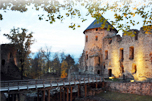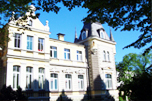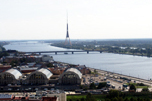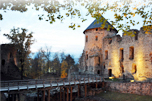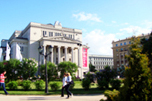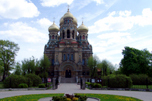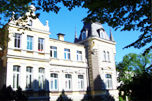Tibet is located in the southwest of China. It formally belonged to the domain of the Yuan Dynasty in the mid - thirteenth century. Although China has undertaken changes and replacements of dynasties and central governments in Chinese history, Tibet has always been under the controll by the central government and been an inseparable part of China.
Today is an age of information with jet aircrafts, highways and network of computers as its symbols. Mysterious places are rare to be found in the world, but Tibet is an exception.
Because of its geographical position , unique topography and terrain ; unknown but existent original customs and natural scenery ; and various propagandas brought back by foreign explorers, all these render people possible to form a mysterious picture of Tibet.
Tibet is located in the southwest of China. It is bordered by Xingjiang, Qinghai , Sichuan, and Yunan provinces of China. The south and west of Tibet is joined with Burma, India, Sikkim, Bhutan, Nepal and the Kashmir region. The boundary line reaches 4000 km long. Tibet has 1.2 million Square kilometers which is equivalent to the total area of five countries as U.K. , France, Germany, Netherlands and Luxembourg.
The averaged altitude is above 4000 metres high. Tibet is the largest and highest plateau in the world, Therefore it is called the'' roof of the world'' , and shares the name of the '' third pole of the earth''. Tibet is surrounded by highmountains with Kunlun mountains in the north. Himalayas mountains in the south, Kela Kunlun ranges in the west and the steep Hengduan ranges in the east. The Mount Qomolangma is situated between China and Nepal with 8848 meters high, which is the highest peak in the world. It is the ideal place for mountain climbers of the world.
Due to the different geographical conditions, temperatures of the south grassland and north plateau differ sharply.The south is warm and rainy. The mean annual temperature is 8? with the lowest -1 6?, the highest 1 6? in July.Most rain falls during May to September. The north climate belongs to continental climate.The mean annual temperature is below 0? .Freeze time covers half year. The highest temperature is under 10?in July, It is warm from June to August. It is a relatively dry area in the north, The weather differs sharply during day and night. The best time for travelling is from March to October.
Tibet has more than 1500 lakes and rivers which cover 30 % of the total lake area in China. The Yarlung Zangbo River, which is one of the main rivers in the region, is 2057 km long. Tibet is one of the largest forest areas in China. High forests are found mainly in the mountains from the east to Yungui plateau. Rdzayul, Smangling, Metog and Spobo counties have more than 90 % surface areas covered by forests. Wild animals are indicative of Tibetan abundant natural heritage. Wild cattle, donkey, yellow lamb, antelope, roe - deer, deer, leopard, tiger, bear, wolf , lynx, otter, snow pig, snow chicken and yellow duck. The natural reserves and extensive wilderness make Tibet a virgin land for ecological and hunting travel .
Tibet has a long historical culture. Ancient remains show that human beings lived here from 4 thousand to 20 thousand years ago. Tibetans are so diligent and brave that they create vital and diverse cultural customs. This is a nation filled with special traditional culture and a nation keen on dancing and singing.
Tibet is advanced in astronomy, ancient algorithm and medicine. Tibet is abounded of classics and literature works. Among Tibetan greatest art treasures are painting, architecture, carving, music, dancing, folk opera, and famous ancient art sites all around Tibet.
The most well - known sites are the Potala Palace, Norbo -glingkha, Sera Temple, Drepung Temple, Dgavldan Temple, Gtsug- lag - Khang Temple and Ramoche Temple in Lhasya ; Zhaxilhunbo Temple, Gzhis - rtse - rdzong in Gzhis - ka - rtse ; Rnan - sras -gling Garden, and Smin - grol - gling in Granang ; Byang - pa - gling Temple, Kharub site in Chab - mdo ; Mtho - Iding - dgon - pa in Rgyal rtse; Mtho - Iding Temple, Guge Kingdom site in Rtsamdva ;Khra - vbrug Temple, and Yambulha - khang in Snevu - gdong ; the tomb of Tibetan King in Qiongjie. The tour of these places and the custom of the nationality are the most special in the world.
At the beginning of this century, Mr. Sven Hedin, a Sweden explorer who made the first travel to Tibet from the western world, arrived at Gzhis - ka - rtse with only two horses and one mare which were ever as many as 130 horses and mares when he first entered Tibet. He said in his?Travel in the Asian Continent'' that in Tibet, ? every step we'd taken made a new discovery about the earth and each name of the place meant a new occupation. We knew nothing about this part of our planet as we did the back of the moon until Jan.1907 '' .
Transportation in Tibet has changed a lot through out this century. From the time Mr. Sven Hedin entered Tibet at the first half of the century, there was not even one mile of road or one truck, and the transportation was based on man's labour and stock. Yak conveyance from Lhas to Yaan was only once a year. After 1 950 when slavery was eliminated, four distinct roads from Sichuan, Qinghai , Xingjiang and Yunnan to Tibet were built through great difficulties. And at the same time inside this autonomous zone, road nets formed centred Lhasa, Gzhis - ka - rtse, Chabmdo and Nagqu, which extended to 98 percent of the counties. Railway from Qinghai to Tibet was built at this time. Skin raft and wooden boat could pass through the Yarlung Zangbo River, Lhasa River, Nianchu River and Niyang River. In 1956 , airmen succeeded in their first aerial navigation above the Qingzang plateau which ever meant the ''forbidden area '' . Now there are regular flights flying to and fro between Lhasa and many cities such as Beijing, Chengdu, Chongqing and Kathmandu Of Nepal.
Tibet, like many other areas, has changed much after our country' s opening reform beginning at the end of 1970s of this century. It attracts tourists coming from all over the world. Mending and exploring scenic spots and historical sites, building hotel , arranging tour buses, training guides, managers and servants have made Tibetan tourism prosperous.
Now tourists can enter Tibet in many ways, by bus from Xingjiang, Qinghai , Sichuan or Yunnan ; by air from Beijing, Chengdu or Chongqing to Lhasa .Through Dro - mo foreign tourists from Bhutan, Sikkim and India Can make their tour in Rgyal - rtse, Gzhis -ka - rtse, Ding - ri or Lhasa, or through Spu - hrangs tourists from Nepal and India can enter Ali area, if they are by air, they can take a direct flight from Kathmandu to Lhasa.
In Tibet , not only can the tourists take the buses provided by local tourist department, but can ride a horse, a yak or a donkey and walk as well.
Modern tourists are eager to return to and enjoy the nature. Tibet has large area, fewer population, high mountains covered with snow, rich forests, booming azalea on hillside, rampage rivers and calm lakes. Most of the places have not been polluted and are sending forth a delicate, original fragrance. In these places people enjoy the bounty of the nature.
Many modern tourists yearn for an exotic atmosphere and the different culture of other countries and seek for new experience. Plentiful and particular content of Tibetan culture is one of the most characteristic parts of Chinese culture and the resources attracting many more tourists.
Located along the Dmarpo - ri mountain, northwestern to Lhasa , Capital of Tibet, the Potala Palace was built after the seventh century. It is 13 floors high, takes an area of 41 hectares and it is piled up with granites with thousands of halls.Inside the Palace, there are coffin towers of corpses of Lama through the ages and sorts of scripture halls. Every coffin tower is luxurious, decorated with gold foils, pearls and jades. The largest tower of the fifth Lama is 14.85 metres high, its decoration contains 119 thousand liangs of gold, 4 thousand pearls of all sizes and countless other jewels. Dalai lived, worked and made the Buddhist services in the Potala Palace. His bedroom was on the top of the Palace with a whole day 's sunlight so as to be called '' sunlight hall '' . After the peaceful liberation of Tibet, the Potala Palace was set up by Chinese Central Government to be the important site of preservation of cultural relics and maintained with fixed fund provided by government. From the spring of 1989 to the summer of 1994 , government appropriated a sum of 53 million yuan to maintain it and this made the Potala Palace more splendid and luxurious.
At the center of Lhasa, Vphrul - snang temple was built in 647 for Tubo king of Tibet, Sogtsan Gambo to marry the Han princess Wencheng of Tang Dynasty. There were Buddhist and scripture halls inside the temple which was covered with golden tile ceiling to make it more brilliant. Vphrual - snang temple' s style originated from both Tang Dynasty and Nepal , India. Right on the center of the hall consecrates the same size of a golden statue as Sakyamuni when he was twelve. On the passage and four sides of the hall , there is a lively Tibet fresco, nearly one thousand meters long, which depicts the grand view when the Han princess Wencheng entered Tibet, and many fairy tales are told.
Along the Barkhor street close to the Vphrul - snang temple stand stores one by one, which are opened and run by local merchants and those from Nepal an India. They sell many kinds of handicrafts with distinctive national features. What attracts the tourists most is people in the street. They put the palms together, put their heads, arms and knees down to ground, move forward slowly every step with a kowtow. This is the highest admiration of Lama to express the most honest hearts to the Buddhists, Some of them come here far away with a step, a kowtow ; and some from local areas. In the morning they kowtow around Vphrul - snang temple for half an hour, then go home to change their clothes, wash their hands, have breakfast and go to work. This kind of kowtow is a physical movement all over the body like Taiji and Qigong popular in the interior of the country. Although it is a religious movement, new content makes it a specular life style of Lhasa inhabitants.
Tourists are also interested in Gzhis - ka - rtse rdzong and Zhaxilhunbo temple of Gzhis - ka - rtse city.? Rdzong '' means a fort, or a mountain fastness in Tibet language. Like other religious buildings such as Potala Palace, Gzhis - rtse - rdzong is located on the top of a high mountain. It was once used as both a military fortress and local authorities of former Tibet's local governors. It was built in Ming and Qing Dynasties installing scripture halls, Buddha halls, county magistrate offices, courts, jails, and storehouses, etc. There is a secret water channel connected with water resource. All these features are unique evolved from the long history of the old fort building development.
Zhaxilhunbo temple is the biggest one of the Sect during the later Tibet with a history of five hundred years. It is the center of religious and political movement of Panchen Lamas. There are over fifty scripture halls and more than two hundred rooms built along the mountain slope. In the Maitreya Hall , 30 metres high, the seated Maitreya bronze statue, 26.2 metres high, is consecrated. The Maitreya ' s hat, face, breast, waist and foot each stands for one floor of the Hall. The bronze statue is composed of 6,700 liangs of gold and 230 thousand jins of red copper and there are one thousand and four hundreds of diamonds, pearls, and ambers and decorated between the brows of it.
Despite that Tibetan scenic spots and historical sites have plentiful contents and unique features, what makes the tourists yearn for is its charming local conditions and customs. There are many festivals here, even in every month, such as Tibet Calendar Year,the Lantern Festival, Bathing Festival and Flower Display Festival , etc. lf tourists happen to come to the festival, they will be invited to sing, dance, drink and enjoy together with local people. Tibetans are hospitable to ask the tourists to visit their homes, to understand and participate in Tibetan daily life, and to experience the new and interesting life styles.
In 1980 , there was only one hotel with less than 100 beds to receive abroad tourists in Tibet. But till the end of 1993 there were 78 restaurants or hotels with 1329 guest rooms. A Sino - foreign 3 - star hotel was built by the International Holiday Inn in Lhasa. Many hotels' architecture adopted the Tibetan style but was decorated inside with modern equipment. If the tourists want, they may live in Tibetan houses or Tibetan tents.
There are traditional dishes and foods, such as butter from cow and sheep milk, butter tea mixed with butter and tea that is decocted from brick tea, glutinous rice cake made of highland barley and pea, barley - brew drinks yoghurt, milk residue and air - dry meat, etc. ALL these are tasted specially. Hosts toast the tourists to make them in a more tipsy feeling and a higher tourist interest. Besides, there are Chuan, Lu, Cantonese and Yang dish series here and western - style food in some restaurants.
Tourists can choose many mementoes, full of Tibetan feature, to buy, such as Tibetan wooden bowl with fine figure, colourful jadewares and stonewalls, antique earthenwares, exquisitely wrought gold and silver vessels, Tibetan knife and various handicrafts, wooden fabrics and Tibetan joss sticks.
On the other hand there are plenty of recreational activities in Tibet. From long time ago, Tibet has been called "Ocean of Singing and Dancing '' , and everyone here can sing movingly and dance gracefully. Tourists can enjoy or if they want, they can take part in all these activities.Guoxie and Guozhang dance are the popular collective dances in Tibet. Hand in hand, arm in arm, with one side the men and the other side the women, people dance while singing, following the rhythm by stamping their feet. Sometimes they sing separately and sometimes collectively. Drum dancers and Reba dancers put on colorful clothes, hang big drums on their waists, wave the drumsticks, move ahead and back with powerful rhythm. In addition, there are other dances like Duixie dance and Lexie dance or Tap dance that highlights the foot movements, romantic dance that is expressed by buckling the breasts and holding the arms, and some, prompt dances while singing and dancing imitating sowing seeds, pulling up weeds, harvesting, twisting the sheep's wool, spinning cottons, milking cows and making butter, etc. Moreover, Tibetan drama is spectacular to the tourists as its performers act while singing with colorful masks.
Touring in Tibet, the unique contents of food, shelter, transportation and bargain can make the tourists greatly excited. When they enter Tibet, they enjoy revealing the mysterious veil covering this area and seeing the amazing and elegant demeanour behind the veil.
Now there are many tourist activities such as mountain-climbing,river-exploring.skiing, motor - bicycle - riding, hiking, horse - riding, boat - rowing, hunting, fishing, sun and hot spring bathing. Categorical tourists like scientific exploration and sorts of scientific conferences have begun, including Tibetan study, Tibetan medical science, ethnology, meteorology, geology, geography, trade, architecture, religion, history, archaeology, culture, art, altitude disease and highland animal and plant. And with the further development of the reform, business and vacation tour will be seen in the making.
Two circular tour routes are open in Tibet in 1 993, the east one and the west one.The east one goes from Lhasa through Maldrolgungkar-Kongpo rgya-mdav-Nying Khri-Sman-gling- Snang - shan - Rgya - tcha - Rtse - thang back to Lhasa again, the west one : Lhasa - Gzhis - ka - rtse-Rgyal - rtse-Sa- dgav- Vbrong - pa-spuhrang-sger-Shiquanhe-Dge - rgyas-Sger - rtsa -Tshochen-22 Daoban-Rgyal rtse-Lhasa. The two routes enlarge the territory in activity for tourists in Tibet.
It is more convenient to ask help of the travel agency rather than walk alone. The travel agency can provide both single and manifold services such as communications, receptions, lodgings, interpretation, and tour guide. Among 21 travel agencies, 14 are exclusively providing services for foreign tourists. They have many guides and interpreters of English, Japanese, German and French. In addition, they have set up agencies in Beijing and Chengdu and long - term organizations in Hongkong and Kathmandu to supply the consulting services for the tourists.
From 1980 to 1993 , admissions to the Tibet totalled about two hundred thousand and foreign exchange earnings were up to $ 65 million. In 1994 , 27 , 927 person - times were received which was an increase of 13 % of that in 1993. And each tour norm had reached the highest level of the history. By the end of 1993, in Tibet there have been 3,128 persons engaging in tour profession of the first stage.
There is huge potential capacity of Tibetan tour. The tour film ? Tibet- Tibet '' , shot by Chinese Travel Agency in 1 985, gained the gold medal in the international tour film festival in France. It reflected the world's big interest in Tibetan tour. The film festival commettee praised the film highly, '' The magnificent figure, a new view to the old civilization and melodious music has pulled the film's exotic atmosphere to the climax.''
At the begining of 1990s, the World Tour Organization sent experts to Tibet to discuss and form ?the Development Project of Tibetan Tour in 1991- 2005 '' . In this project, the annual growth rate of both guests and earnings will be 20 % to 30 % with the development of the guest market, the communication, the infrastructure and the advertisement. To 2000 , Tibetan tour will show a state of high speed development by receiving 75 thousand person - times and foreign exchange earnings of 52 million dollars.
Tibetan tour' s mystery is being desalinated with the fast development of Tibetan tour and more tourists. And for seeking and enjoying the remaining mystery, tourists should come to Tibet as early as possible.
